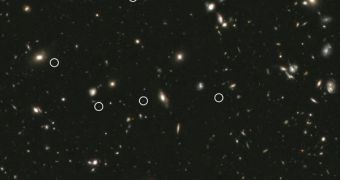Thanks to new investigations, astronomers are now able to better understand one of the most important events to have ever taken place in the Universe. The reionization epoch, which paved the way for all galaxies to form, was a critical stage of cosmic development.
Using the NASA Hubble Space Telescope, scientists looked at the earliest galaxies in the Universe and determined that their role in promoting the reionization epoch was one of the utmost importance.
The study shows that it was these early structures that acted as a source for large amounts of ultraviolet radiation. These radiations then went on to ionize atoms around them, setting the stage for even more galaxies to form.
For this investigation, Hubble looked at galaxies located some 12.9 billion light-years away, which means that they appeared some 800 million years after the Big Bang. The reionization epoch is believed to have concluded some 1.1 billion years after the cosmic inflation began.
The reason why this stage was so important for the Cosmos is that all light that was emitted within was being absorbed by hydrogen gas. When the gas was ionized, light was able to pass through again.
One of the leading theories to explain what was going on so early in history is that galaxy mergers and growth were responsible for the ionization of gas bubbles around them.
Eventually, as more and more galaxies developed, the bubbles of reionized gas they affected overlapped, meaning that all the hydrogen gas in the Universe had been affected. Still, this explanation comes a bit short on providing details about the timing of these events.
“That has been the outstanding question. At what point in time do galaxies produce enough of these ionizing photons to keep the electrons and protons in the Universe unbound?” says Brant Robertson.
The expert holds an appointment at the California Institute of Technology (Caltech), in Pasadena, California. He adds that the 2009 repair efforts conducted on Hubble is what allowed experts to try to refine the theory now.
“The thing that's changed recently is the installation of the new camera on Hubble,” Robertson explains for Space. Details of the new work appear in the November 4 issue of the esteemed journal Nature.
Using the Wide Field Camera 3 on the telescope, scientists were able to track down the infrared signatures of an estimated 50 galaxies that existed in the Universe before the end of the reionization epoch.
Studies conducted with the new instrument showed that an estimated 10 to 20 percent of the ultraviolet photons produced in these early galaxies escaped outside the structure, influencing the gas around.
Even if some degree of uncertainty still persists, experts estimate that, by 800 million years after the Big Bang, there were enough UV photons in the Cosmos to reionize it entirely.
But experts are hopeful that the uncertainty percentage will decrease as Hubble investigates a larger swath of the sky, looking for old galaxies.
“It's a very exciting time. In the next couple of years we'll be able to know if there are enough galaxies to re-ionize the Universe,” Robertson explains.

 14 DAY TRIAL //
14 DAY TRIAL //